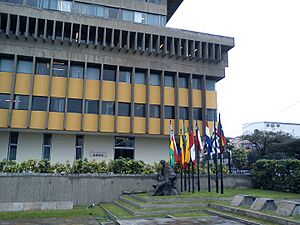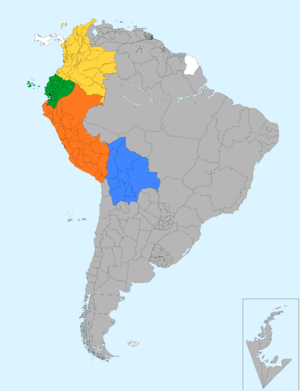Andean Community facts for kids
Quick facts for kids
Andean Community
Comunidad Andina
|
|
|---|---|
|
Flag
|
|
|
Motto: "Ésta es mi tierra, ésta es mi casa" (Spanish)
"This is my homeland, this is my home" |
|
 |
|
| Seat of Secretariat | Lima, Peru |
| Largest city | Bogota, Colombia |
| Official languages | |
| Type | Trade bloc |
| Member states |
|
| Leaders | |
|
• Secretary General
|
Jorge Hernando Pedraza |
| Establishment | |
|
• as the Andean Pact
|
1969 |
|
• as the CAN
|
1996 |
| Area | |
|
• Total
|
1,470,702 sq mi (3,809,100 km2) (7th) |
| Population | |
|
• 2010 estimate
|
101,119,783b (12th) |
| GDP (PPP) | 2017 estimate |
|
• Total
|
$902.86 billion (9th) |
|
• Per capita
|
$8,928.62 |
| HDI (2017) | 0.781 high |
|
Website
http://www.comunidadandina.org/ |
|
|
|
The Andean Community (Spanish: Comunidad Andina, CAN) is a group of countries in South America. It works like a special club for trade. Its main goal is to create a customs union. This means that goods can move freely between member countries without extra taxes.
The countries that are part of the Andean Community are Bolivia, Colombia, Ecuador, and Peru. This group was first called the Andean Pact when it started in 1969. It changed its name to the Andean Community in 1996. The main office, or headquarters, is in Lima, Peru.
The Andean Community covers a huge area of about 4.7 million square kilometers. More than 113 million people live in these countries. Together, their economies are very strong, making it an important group in South America.
Contents
Who are the Members of the Andean Community?
The Andean Community started with five countries in 1969. These were Bolivia, Chile, Colombia, Ecuador, and Peru. Later, Venezuela joined in 1973. However, Chile left in 1976, and Venezuela left in 2006. This left the group with its current four full members.
The Andean Community also has "associate members" and "observer countries." Associate members are countries that work closely with the group on trade. Observer countries watch what the group does and might join later.
- Current full members:
- Associate members:
- Observer countries:
- Former full members:
How the Andean Community Works with Other Groups

The Andean Community (CAN) and Mercosur are the two biggest trade groups in South America. They have been working together to create an even larger "South American Free Trade Area" (SAFTA). This would allow goods to move freely across almost all of South America.
In 2004, CAN and Mercosur signed an agreement to work towards a "Union of South American Nations" (USAN). This union would be similar to the European Union, bringing countries closer together.
Sometimes, countries change their minds about which groups to join. For example, Venezuela decided to leave the Andean Community in 2006. This was because some other CAN members signed trade deals with the United States. Venezuela later became a full member of Mercosur in 2012.
Even though countries might leave or join different groups, the goal is often to make trade easier and help the economies of South American nations grow. Bolivia, for instance, is a member of several groups. This helps it act as a link between different parts of South America.
Key Moments in the Andean Community's History

- 1969: The group started with the Cartagena Agreement. It was called the Andean Pact.
- 1973: Venezuela joined the Andean Pact.
- 1976: Chile left the Andean Pact.
- 1979: The Andean Court of Justice and the Andean Parliament were created.
- 1993: A "Free Trade Zone" began for Bolivia, Colombia, Ecuador, and Venezuela. This meant goods could move freely between them.
- 1996: The group changed its name to the Andean Community (CAN).
- 1997: Peru began to slowly join the Andean Free Trade Zone.
- 1998: An agreement was signed to create a free trade area between the Andean Community and Mercosur.
- 2006: Venezuela announced it would leave the Andean Community.
- 2017: The Andean Community signed an agreement with the Eurasian Union.
- 2020: Venezuela announced it would rejoin CAN.
How the Andean Community is Organized
The Andean Community has several important parts that help it run smoothly:
- Andean Presidential Council: This is where the presidents of the member countries meet.
- Andean Foreign Relations Ministers Council: Foreign ministers from member countries meet here. It is located in Lima, Peru.
- Commission: This group helps make decisions for the community. It is also in Lima, Peru.
- Andean Court of Justice: This court helps solve disagreements between member countries. It is in Quito, Ecuador.
- Andean Parliament: This is a group of representatives from the member countries. It is in Bogotá, Colombia.
- Latin American Reserve Fund: This fund helps support the economies of member countries. It has offices in Bogotá, Colombia and Lima, Peru.
- Simón Bolívar Andean University: This university helps educate people from the region. It has campuses in Sucre, Bolivia and Quito, Ecuador.
- Andean Health Organization: This group works on health issues for the region. It is in Lima, Peru.
- CAF – Development Bank of Latin America and the Caribbean: This bank helps fund projects in the region. It is in Caracas, Venezuela.
Leaders of the Andean Community
The Andean Community has a Secretary-General who leads the main office. Here are some of the people who have held this important role:
- Sebastián Alegrett (Venezuela) 1997–2002
- Guillermo Fernández de Soto (Colombia) 2002–2004
- Edward Allan Wagner Tizón (Peru) 2004–2006
- Alfredo Fuentes Hernández (Colombia), interim 2006–2007
- Freddy Ehlers (Ecuador), 2007–2010
- Adalid Contreras Baspineiro (Bolivia), interim 2010–2011, 2011–2013
- Pablo Guzmán Laugier (Bolivia), 2013–2016
- Walker San Miguel (Bolivia), 2016–present
Easy Travel Between Countries
Since January 1, 2005, citizens of the Andean Community countries can travel to other member states without needing a special visa. They just need to show their national ID cards.
When visiting Venezuela, travelers need to show their passports. They will then get an "Andean Migration Card." This card shows how long they can stay in the country.
Andean Passport
The Andean passport was created in 2001. It is a special passport that looks the same for all member countries. It has common features for names and security. This passport is used in Ecuador, Peru, Venezuela, and Bolivia.
See also
- Central American Common Market
- Community of Latin American and Caribbean States
- Customs Union
- Free Trade Area of the Americas
- Mercosur
- Trade bloc
- Union of South American Nations
- Rules of Origin
- Market access
- Free-trade area
- Tariffs
Images for kids
-
Exclusive Economic Zones of the member states of the Andean Community. This shows the ocean areas where member states have special rights.




